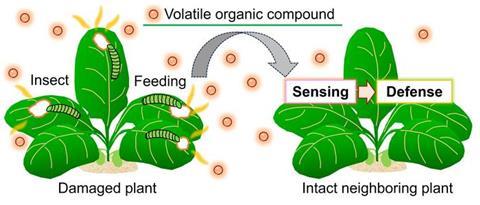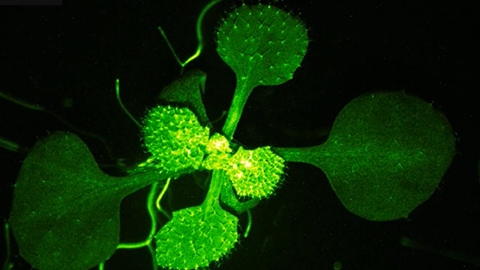The smell of freshly cut grass: just another example of how plants communicate using volatile organic compounds, in this case to indicate that they are injured. It is known that other plants pick up and process these signals, but how they do so has been a mystery. Now, in Nature Communications, Japanese researchers show how this happens in real time.
When plants are damaged, volatile organic compounds such as terpenes and 6-carbon alcohols, aldehydes and esters are released. These trigger the plant’s defences, including sending Ca2+ signals to the rest of the plant. The volatiles released also cause plants in the immediate vicinity to switch on their defence systems. They are ready for what could be an imminent attack by voracious insects.
But how plants perceive these VOCs was unknown until now. To find out, researcher Masatsugu Toyota and his team at Saitama University in Japan built a custom system to detect fluorescent light in living plants. Before the research, however, Toyota was ’a little concerned about whether the plant could actually smell the volatiles’.
Surprise
For the study, the researchers used Arabidopsis equipped with a fluorescent calcium biosensor. This allowed them to detect varying levels of calcium in the cell. When the researchers exposed the plants to VOCs from bruised or caterpillar-eaten leaves, the biosensor lit up: first in the leaves closest to the source, then in those further away. ‘That was a real surprise to me’, says Toyota.
Next, the researchers worked out which specific compounds the plant was ‘smelling’. They analysed nine volatile organic compounds known to trigger plant defences. Of the nine, Arabidopsis was found to ‘smell’ two of them, the 6-carbon aldehydes (Z)-3-hexenal and (E)-3-hexenal. When the researchers exposed the plants to these compounds, the calcium biosensor lit up within a minute and the plant switched on its defence genes.

In damaged plants, the Ca2+ signal travels from the damage to the rest of the plant. To find out how far the Ca2+ signal travels in undamaged plants, Toyota and his team placed Arabidopsis plants in a closed chamber with only one leaf sticking out. When this leaf ‘smells’ (Z)-3-hexenal, the biosensor lights up, but only in the protruding leaf. In undamaged plants, there is only a Ca2+ signal in the tissue that can detect (Z)-3-hexenal.
Stomata
Finally, the researchers investigated which cells the plant uses to ‘smell’. To do this, they placed the biosensor in specific cells: the epidermis or surface cells, the stomata and the mesophyll or inner cells of the leaf. Exposure to (Z)-3-hexenal led to rapid illumination of the stomata, followed by the mesophyll. Surprisingly, however, the epidermis cells barely glowed.
To confirm that the stomata are indeed the ‘nose’ of the plant, the researchers treated the plants with abscisic acid. This closes the stomata. Once closed, the biosensor lit up much more slowly after exposure to (Z)-3-hexenal. ’This shows that open stomata are important for the perception of volatile organic compounds in the leaf’, says Toyota.
‘The beauty of the study is that it is so beautifully visualised’, says Rob Schuurink, plant researcher at the University of Amsterdam, who was not involved in the study. ’We knew that plants respond to volatile organic compounds, but now you can actually see it.’ The fact that we can observe at the tissue level what is happening when plants perceive volatiles is ‘very exciting’, says Schuurink.
Diluted
Toyota sees applications in crop protection. But before that happens, ’they still have to show that it works in nature’, says Schuurink. For example, it has to be shown that the concentrations used in the study also occur in nature, and that they are not too diluted by the time they reach a neighbouring plant.
For the time being, this study mainly provides information for further research. For example, there is the question of whether there is a priming effect after exposure to a low concentration of (Z)-3-hexenal, where nothing appears to happen after the first exposure, but there is a reaction after a subsequent exposure. In addition, Toyota is still looking for the receptors that initiate the calcium signal after binding of (Z)-3-hexenal and (E)-3-hexenal.
Aratani, Y. et al. (2023) Nat. Commun. 14(6236). DOI: 10.1038/s41467-023-41589-9













Nog geen opmerkingen